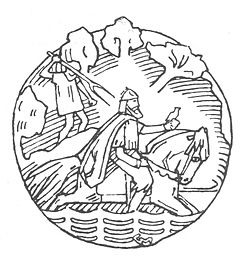| Ynglinga Saga | |
|---|---|
 An illustration by Gerhard Munthe for Ynglinga saga | |
| Full title | Ynglinga Saga or The Story of the Yngling Family from Odin to Halfdan the Black |
| Author(s) | Snorri Sturluson |
| Language | Old Norse |
| Date | about 1225 |
| Series | Heimskringla |
| Genre | Chronicle |
| Period covered | until 1177 |
| Text | Ynglinga Saga at Wikisource |
Ynglinga saga (modern Icelandic pronunciation: [ˈiŋliŋka ˈsaːɣa]) is a Kings' saga, originally written in Old Norse by the Icelandic poet and historian Snorri Sturluson about 1225. It is the first section of his Heimskringla. It was first translated into English and published in 1844 by Samuel Laing.[1]
Snorri Sturluson based his work on an earlier Ynglingatal which is attributed to the Norwegian 9th-century skald Þjóðólfr of Hvinir, and which also appears in Historia Norwegiae. It tells the most ancient part of the story of the House of Ynglings (Scylfings in Beowulf). Snorri described the descent of the kings of Norway from this royal house of Sweden.
Ynglinga saga is the first part of Snorri's history of the ancient Norse kings, the Heimskringla. Interwoven in this narrative are references to important historical events.
The saga deals with the arrival of the Norse gods to Scandinavia and how Freyr founded the Swedish Yngling dynasty at Uppsala. Then the saga follows the line of Swedish kings until Ingjald (Ingjald illråde), after which the descendants settled in Norway and became the ancestors of the Norwegian King Harald Fairhair.